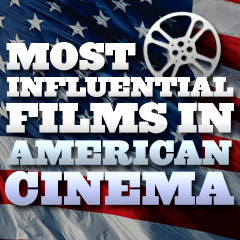Most Influential, Significant
and Important Films in American Cinema
(chronological by time period and film title)
|
|
Title Screen
|
Film Title/Year/Director/Length/Studio,
Descriptions of Influence/Significance |
Poster
|
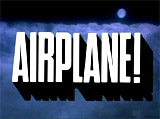
|
Airplane! (1980)
d. Jim Abrahams, David Zucker, Jerry Zucker, 88 minutes,
Paramount Pictures
- A trend-setting, zany, hilarious comedy - using
the airplane disaster film, such as Zero Hour! (1957), The
Crowded Sky (1960), and the "Airport" series of films (especially Airport
1975 (1974)), as a spoof stepping stone, from the comedy writing/directing
team of David Zucker, Jim Abrahams and Jerry Zucker (known colloquially
as ZAZ and their brand of "ZAZ humor").
- The comedy aggressively spoofed (like Mel Brooks'
films) the entire disaster film genre of the 70s with its
fast-paced jokes, sight gags, and sexual double entendres. It reinforced
the idea that one could pack a movie-length feature with dozens
of wall-to-wall jokes (similar to early TV comics Sid Caesar and
Carol Burnett) and succeed - even if all the quips weren't funny.
- This film, one of the greatest comedies ever made,
was preceded by the directors' screenwriting for John Landis'
The Kentucky Fried Movie (1977) (the ZAZ trio of comedy
writers were known as The Kentucky Fried Theater when they performed
as a Wisconsin comedy troupe), and later followed up with Top
Secret! (1984), and Ruthless
People (1986).
- Airplane's joke-filled plot was an excuse
for a frantic, slapstick parody filled with visual-sight gags,
puns, verbal literalism ("Surely
you can't be serious." "I am serious, and don't call me
Shirley"), rapid-fire satirical wisecracks, irreverent references
to From Here to Eternity (1953) and Saturday
Night Fever (1977) disco
dancing, and visual non-sequiturs, and much more. The simple plot
was about shell-shocked, flight-phobic, ex-military pilot Ted Striker
(Robert Hays) who pursued ex-girlfriend Elaine (Julie Hagerty) -
a stewardess on an ill-fated flight from LA to Chicago with stricken
pilots.
- It began with the opening credits sequence set
to the familiar music of Jaws (1975) with
the plane's fin appearing through the clouds.
- This
movie revitalized the acting careers of Peter Graves, Lloyd
Bridges, and Robert Stack, and launched the comedy career of Leslie
Nielsen as the straight-faced, dead-panning doctor, who up to that
time was known mostly for B-movie dramatic roles, in films like Forbidden
Planet (1956) and The Poseidon Adventure (1972). He went
on with the ZAZ comedy team to originate the character of police
Lt. Frank Drebin in their Police Squad! TV series - and recreated
the role in the many The Naked Gun films.
- Followed by a less
funny ZAZ-less Airplane II: The Sequel (1982) by director Ken Finkleman.
|
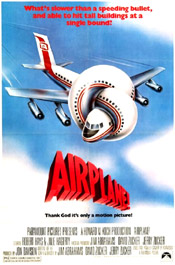
|
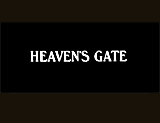
|
Heaven's Gate (1980)
d. Michael Cimino, 149/219 minutes, Partisan Productions/United Artists
- This notorious, big-budget epic film was a major financial
disaster for its studio (United Artists, the studio of Charlie Chaplin,
D.W. Griffith, Mary Pickford and Douglas Fairbanks) - it also was
a disaster for the western film genre for the remainder of the 80s,
and it ended the reign of the New Wave of 1970's 'auteurs' or independent
film-makers.
- The film became the biggest flop in film history
at the time (US box-office was only about $1.5 million), and since
then has become synonymous for any film judged to be a monumental
'turkey' that faced major financial disaster.
- Its self-indulgent, financially-irresponsible and
excessive writer/director who had been praised for his Best Picture
and Best Director-winning The Deer Hunter
(1978), took the brunt of much of the film's criticism,
for its ballooning budget that was almost six times above-budget
to produce (from $7.5 million to about $44 million), for its overlong
incomprehensible plot (originally a 5-hour version that was cut
down to 219 minutes), for its miscasting and slow pacing, for its
expensive on-location shooting and fastidious over-attention to
detail and historical accuracy, and for allegations of animal abuse
- all for a film without major stars.
- Following its initial release in late 1980, the
film was pulled from theatres, edited down by over an hour in length,
and re-released a few months later, although it still failed miserably.
UA's corporate parent, Transamerica, was forced to sell the bankrupted
studio to MGM for only $350 million as a result.
- Michael Cimino's expensive 'boondoggle' film and revisionistic
Western told about the Johnson County Wars between starving Eastern
European immigrant farmers and mercenaries hired by the cattlemen.
- Heaven's Gate was one of the first films
to be prejudged by a critic. The infamous review of New York
Times critic Vincent Canby ("It fails so completely that
you might suspect Mr. Cimino sold his soul to obtain the success
of The Deer Hunter and the Devil has just come around to
collect") built negative press until Cimino's film was doomed
to have an un-profitable theatrical release.
- The film received
numerous Razzie Award nominations including a Worst Director prize
for Cimino, although it received generally positive reviews after
release to video, and fairly good results from its international
box-office. It was critically re-evaluated by the LA-based Z Channel
when it premiered on cable TV in its uncut version in 1982, but
it was already too late.
|

|
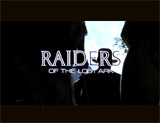
|
Raiders of the Lost Ark (1981)
d. Steven Spielberg, 115 minutes, Paramount Pictures/Lucasfilm
- A spectacular, cliff-hanger, breathlessly-paced,
non-stop action/adventure film of the early 1980s - it was an immensely
successful summer box-office hit. This was the
first full collaboration between two legendary American film-makers:
producer George Lucas and director Steven Spielberg. Raiders remains
a thoroughly entertaining work, with some of the greatest gee-whiz
technical effects (created at Lucasfilms' Industrial Light and Magic),
kinetic stunts, larger-than-life characters, and continuously chained-together
action sequences ever filmed.
- This exciting adventure-fantasy
film introduced the character of bullwhip-carrying, fedora-wearing
Indy Jones (Harrison Ford). Its tale was about the search for the
Bible's Ark of the Covenant involving sadistic Nazis, a duplicitous
Frenchman, snakes, exciting chase sequences, and the blinding-zapping
climax followed by an ending scene deliberately reminiscent of
one of the final scenes in Citizen Kane (1941).
From Nepal to
Cairo, the self-effacing hero was aided by tough, hard-drinking,
spunky and feisty ex-girlfriend Marion Ravenwood (Karen Allen),
as he escaped one life-threatening situation, fight, scrape, and
chase after another - especially venomous snakes and the mysterious
wrath of God in its finale.
- The film received eight Academy Awards nominations,
and came away with four Oscars, mostly for technical categories:
Best Art Direction-Set Decoration, Best Sound, Best Film Editing,
and Best Visual Effects, plus a Special Achievement Award for Sound
Effects Editing.
- Harrison Ford, who had starred in Lucas' Star
Wars (1977), took the role of the globe-trotting, adventurous,
comic-book hero/academic archaeologist with a leather jacket
and bullwhip. The swaggering, two-fisted character with a fear of snakes
was designed to be flawed yet cocky, with frequent boasts: "Trust
me."
- This was the first of four Indiana Jones movies
(1981, 1984, 1989, and 2008) - created as
a tribute (by Lucas) in wide-eyed homage to the episodic Saturday
matinee, cliff-hanging thrillers, westerns, and adventure serials
of yesteryear in the 1930s and 40s, with their strong-jawed heroes.
The film had two classic chase scenes: (1) the opening sequence
with an escape from a trap-laden ancient South American temple,
including a rolling gigantic spherical boulder, and Indy's subsequent
getaway from Rene Belloq (Paul Freeman) and the Hovitos tribe by
running to an awaiting airplane, and (2) the desert chase scene
in which Indy raced after a speeding truck
by mounting a horse and overtaking the vehicle.
- The musical score by accomplished composer John
Williams (famous for work on Jaws (1975) ,
Star
Wars (1977), and The Empire Strikes
Back (1980)) added an air of excitement. Spielberg's phenomenally
successful film, that cost only $23 million grossed $242 million
(domestic) and $384 million (worldwide) - contributed to the
demand for bigger blockbusters.
- Influences on the film came from the many permutations
of the Zorro legend, John Ford's Stagecoach
(1939) with its amazing stuntwork by Yakima Canutt, Gunga
Din (1939), Casablanca (1942), The
Treasure of the Sierra Madre (1948), King Solomon's
Mines (1950), and the Disney Ducks adventure comics
by Carl Barks.
- Unforgettable scenes included the thrilling opening,
the underground Egyptian temple filled with snakes, the tense chase
scenes, and the retribution visited upon the rival, religious artifact-obsessed
French archaeologist and his Third Reich Nazi cohorts in the fiery
finale when the Ark of the Covenant was opened.
- Numerous other films have been influenced by the
trilogy of Raiders films: King Solomon's Mines (1985) with
Richard Chamberlain, Romancing the Stone (1984) and Jewel
of the Nile (1985), the Spielberg-produced The Goonies (1985),
and more recently The Mummy (1999) and The
Mummy Returns (2001), and the Lara Croft film franchise
(from 2001-2007).
|

|
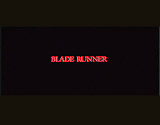
|
Blade Runner (1982)
d. Ridley Scott, 117 minutes, The Ladd Company/Shaw Brothers/Warner Bros.
- Rising director Ridley Scott's
follow-up to his sci-fi horror hit Alien
(1979),
was one of the most popular and influential science-fiction films
of all time - and it has become an enduring cult classic favorite.
The evocative, inventive, stylistic film has improved with age
and warrants repeated viewings. The dense, puzzling, detailed plot
of the film was backed by a mesmerizing, melancholy musical soundtrack
from Greek composer Vangelis - undeservedly overlooked for an Oscar
nomination. It received only two Academy Award nominations without Oscars:
Best Art Direction/Set Decoration, and Best Visual Effects.
- The enthralling film was originally a box-office
financial failure, and it received negative reviews from film critics
who called it muddled and baffling. It also wasn't encouraging
that it faced Spielberg's E.T.: The Extra-Terrestrial
(1982) during its opening release.
- The ambitious, enigmatic, visually-complex film
was a futuristic film noir detective thriller about a hard-boiled,
jaded, semi-retired, Philip Marlowe-style ex-cop detective (Harrison
Ford), known as a "blade runner." He
had been forced out of retirement to hunt down and eliminate four
near-human "replicants" (including Daryl
Hannah, Rutger Hauer, Joanna Cassidy) - genetically engineered
super-humanoid robots with a built-in, shortened life span of only
four years. It
contained all the requisite parts of a detective, film noirish
thriller - an alienated hero of questionable morality, an android femme
fatale (Sean
Young), airborne police vehicles called "Spinners,"
dark sets and locations in a dystopic Los Angeles of 2019, and
a downbeat voice-over narration. The film mixed in some western
genre elements as well, and was thematically similar to the story
in High Noon (1952) of a lone marshal
facing four western outlaws.
- The film's theme, the difficult quest for immortality,
was supplemented by an ever-present eye motif - there were various
VK eye tests, an Eye Works factory, and other symbolic references
to eyes as being the window to the soul. Scott's masterpiece also
asked the veritable question: what does it mean to be truly human?
One of its main posters advertised the tagline: "MAN HAS MADE
HIS MATCH - NOW IT'S HIS PROBLEM."
- Stylistically, the film was arresting with fantastic,
imaginative visual effects of a futuristic Los Angeles conceived
by futurist design artist Syd Mead, and influenced by the vision
of Fritz Lang's Metropolis (1927) and
Kubrick's 2001: A Space Odyssey (1968). One
of the most awe-inspiring visuals in film history was the powerful vision of the Los
Angeles cityscape at night, circa 2019, with giant, fire-belching
towers, floating advertisements, giant television screens, and
police "spinners" (flying cars). Many
films have attempted to duplicate the bleak, dystopic, cyberpunkish
look of Blade Runner, including Batman (1989), Johnny
Mnemonic (1995), Strange Days (1995), The Fifth Element
(1997), Dark City (1998), The Matrix (1999),
and I, Robot (2004).
- The film has become one of the most tampered-with
products, with many different variations. It was originally filmed
without a monotone, explanatory voice-over
in a somber, Raymond Chandler-like manner. After the studio held
disastrous preview test screenings, a noirish, somber,
flat-voiced narration (by lead character Harrison Ford) was added
to make the plot more accessible, and a tacked-on, positive, upbeat
ending (using out-takes from Stanley Kubrick's The
Shining (1980)),
was also added.
- On the film's 10th anniversary, a revised 'Director's
Cut' (of 117 minutes) was released with
a new digital soundtrack, and a number of changes (for example, it
dropped Harrison Ford's mostly redundant voice-over and restored
the film's original darker and contemplative vision). And then
for the film's 25th anniversary in 2007, a more definitive version
contained never-before-seen added/extended scenes. It also added
lines of dialogue, corrected several technical flaws, and included
new and improved special effects.
- A sequel followed, Blade Runner 2049 (2017), set
30 years into the future, and featuring Harrison Ford and Edward
James Olmos reprising their original roles.
|
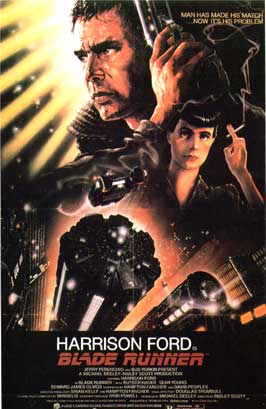
|
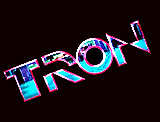
|
TRON (1982)
d. Steven Lisberger, 96 minutes, Walt Disney Productions
and Lisberger/Kushner
- Walt Disney Studios' visually-pioneering, state
of the art (at its time) landmark film was the first true CGI-animated
film. It was released as both a feature film (with more state-of-the-art
computer-generated animation than any other film) and an arcade
video game.
- Writer/director Steven Lisberger used cutting-edge
computer graphics combined with live action (featuring human stars
Jeff Bridges and David Warner) in a tale set within a gladiatorial
computer game. The fantasy inside-a-computer-video-game adventure/science-fiction
film was one of the first films to be derived from the video-game
craze.
- This ground-breaking, escapist film
was heralded as the first live action film with over 20 minutes of
full 3D graphics and computer animation. Its most innovative sequence
(with extensive use of 3-D CGI) was the famed racing bike or Lightcycle
sequence depicting computerized lightcycles in a high-speed race.
The Lightcycle sequence used the artwork and vision of legendary
artists Syd Mead and Jean 'Moebius' Giraud, and visual effects
done with a combined effort by Triple I, MAGI/Synthavision, Robert
Abel & Associates, and Digital Effects.
- Another FX technique used was backlight animation, in which light
was shown through a specialized filter through each frame to create
extraordinarily vibrant colored light effects, in this case, through
the inventive Oscar-nominated costumes worn by the actors.
- The greatest testament to this film's unique visual
effects, soundtrack, costuming, art direction and set decoration
is that none of it has ever been duplicated, and remains unique
to this day. The film also featured a unique soundtrack by Wendy
(nee Walter) Carlos that melded synthesized music with the London
Philharmonic's orchestral music.
- However, the film's failure
at the box-office held up greater development of computer animation.
- With two Academy Award nominations for Best Sound
and Best Costume Design, TRON was disqualified for a Best
Visual Effects award because the Academy believed that it "cheated" by
using a computer - the concept of using computers to craft environments,
rather than drawing them by hand, was considered inauthentic in these
early years. In reality, the process was an extremely arduous
one for animators. Seven years later, James Cameron's The Abyss
(1989) won the Best Visual Effects Oscar for the same kind of technology.
- A sequel followed, titled Tron: Legacy (2010),
with Jeff Bridges and Bruce Boxleitner reprising their roles.
|

|
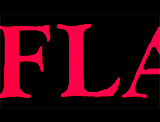 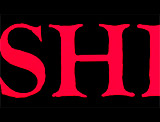 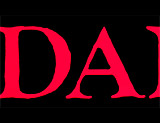 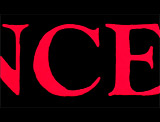
|

|
Flashdance (1983)
d. Adrian Lyne, 95 minutes, Paramount Pictures/PolyGram Pictures
- This R-rated sleeper film hit from director
Adrian Lyne included energetic, glossy music-video style dance
sequences. It
was generally regarded as a formulaic, implausible Cinderella story
of 18 year-old Alexandra "Alex" Owens
(Jennifer Beals), a blue-collar Pittsburgh steel mill welder
(and exotic bar dancer at night at Mawby's Bar) who became a success
as a more legitimate ballet dancer. The most memorable dance scene
was when she performed
supine on a chair as water splashed down on her.
- Adrian Lyne's slick film was immensely popular
with its highly kinetic, music-video style - and an Oscar-winning
original title song ("Flashdance...What a Feeling")
sung by Irene Cara.
- It was a major box-office success and cultural touchstone (the
torn/cut off-the-shoulder baggy sweatshirt, break dancing, ankle
warmers, etc.).
- MTV, a cutting-edge music video channel on cable,
was launched 24/7 in August, 1981. As a result, its style of fast-moving
montage, circumventing conventional narratives with visual storytelling,
was influential on this film and many films that followed with
pop-infused soundtracks (such as Tony Scott's Top
Gun (1986),
particularly the sequence filmed to the tune of "Take My
Breath Away"). It also influenced two other 80s films:
Footloose (1984) and Purple Rain (1984) with its concert sequences.
- Lyne had previously been a TV commercial director,
so his style was characterized by fast-edited clips accompanied
by 80s hit songs in some of the film's sequences, similar to the
style of television advertisements. There were lots of closeups,
fast cuts and blurred action typical of the MTV style.
- The filming style was derided by some critics as
being only a "series of rock videos" and the entire film
was viewed as a 93-minute, youth-oriented music video.
|
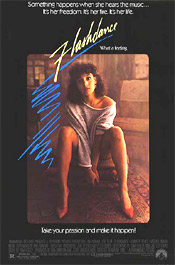
|
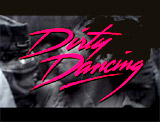
|
Dirty Dancing (1987)
d. Emile Ardolino, 105 minutes, Great American Films Limited Partnership
- This romantic coming-of-age drama and
dance film (about a forbidden summer fling) from Vestron Pictures
became a surprise hit, given its low-budget ($6 million), mostly
unknown stars (including trained dancers/performers 34 year-old
Patrick Swayze and Joel Grey's 26 year-old daughter Jennifer Grey),
and a short 6-week production schedule. It had an extremely popular,
chart-topping soundtrack (including the Best Original Song Oscar-winning "(I've
Had) The Time of My Life"), Its poster tagline was a tie in to
the hit song: "First dance. First love. The time of your life."
- The studio feared the film would flop, and was especially
worried that the controversial and scandalous-sounding title "Dirty
Dancing" suggested that the film was pornographic, but fortunately,
they chose it rather than its alternative: "I Was a Teenage Mambo
Queen."
Most filmgoers didn't know ahead of time that one of the film's
crucial subplots was about the termination (abortion) of an unwanted
pregnancy. The botched, back-alley abortion procedure was described
as performed with a dirty knife on a folding table. [Note: The
film's time frame in the early 1960s meant that abortion was still
illegal in the US, before the passage of
Roe v. Wade in 1973 to legalize abortion throughout the
country. In the state of NY, the state had made abortion
legal in 1970.]
- In the plot of the movie,
college-bound, almost-18 year-old Frances "Baby" Houseman
(Jennifer Grey) was due to attend Mount Holyoke, obtain a degree
in "economics in underdeveloped countries," and then join the Peace Corps. Unexpectedly,
she fell in love with a sexy, working-class dance instructor -
24 year-old resort entertainer Johnny Castle (Patrick
Swayze) during the summer of 1963 at an upstate NY State Catskills
retreat known as Kellerman's Mountain Lodge. There, she was vacationing with her well-to-do
Jewish family, headed by her father Dr. Jake Houseman (Jerry Orbach).
During their stay, Jake served as the personal physician for the
pushy resort owner Max Kellerman (Jack Weston).
- "Baby" first
encountered Johnny at a secret "dirty dancing" party
amongst the off-limits, lower-class resort staff, to the tune of
The Contours' "Do You Love Me?" Towards the end of the
evening, Johnny taught "Baby" to 'dirty dance' to the tune
of Otis Redding's "Love Man." She
soon ran afoul of her entire life's principles and value system by
deceptively lying to her father to obtain $250 to pay for an illegal
abortion for Johnny's dance partner Penny Johnson (Cynthia Rhodes).
However, the womanizing resort waiter Robbie Gould (Max Cantor),
a Yale School of Medicine student, was the one responsible for impregnating
Penny.
- Ultimately, "Baby" was
trained to dance with Johnny to substitute for Penny, to stand-in
for a dance performance at another Catskills hotel - the Sheldrake,
and soon after, they fell in love and had sex together. The film
concluded with a rousing final night talent show for the entire
resort, when Johnny (who had been unjustly fired) returned to the
resort, affirmed the quotable line: "Nobody puts Baby in the
corner," and joined with Baby
to perform the 'last dance' of the season with her - to the tune
of "The Time of My Life." Their tremendous dance sequence
(including a climactic and daring lift move) led to reconciliation
between all the main principals (and especially between the wiser
and more confident
"Baby" and her stern father) as the film concluded.
- The very popular and beloved film grossed
$64.6 million (domestic), and $214.6 million (worldwide), and
was the first film to sell more than a million copies on home video
- it inspired an entire generation of moviegoers to dance and
pursue their dreams. The popular music-filled dance romance
resonated in particular with female audiences who attended multiple
viewings, due in part to its non-objectification of
women, and its progressive feminist viewpoints.
- The original film was
followed by a 3-month national music tour in 1988 in 90 cities
named Dirty Dancing: Live in Concert, featuring Bill Medley and
Eric Carmen. In addition, CBS presented a short-lived TV series
from 1988-1989 titled Dirty Dancing, In 2004, the
film was adapted as a stage musical titled Dirty Dancing: The
Classic Story on Stage.
- The film was also reimagined by director
Guy Ferland with his retreaded prequel version Dirty
Dancing: Havana Nights (2004), including the same
characters (but with new names - Katey (Romola Garai) and Javier
(Diego Luna)) and a similar plot, yet transplanted to Cuba during
the era of Fidel Castro and the Cuban Revolution in the late 1950s.
The 2004 film also included an extended cameo by Patrick Swayze
as a dance class instructor wearing an all-black outfit during
a dance scene. The original film was also remade as a poorly-received
ABC-TV movie musical titled Dirty
Dancing (2017), starring Abigail Breslin.
|
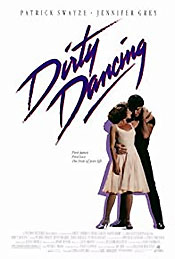
|
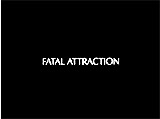
|
Fatal Attraction (1987)
d. Adrian Lyne, 119 minutes, Paramount Pictures
- This was a suspenseful, melodramatic, erotic
thriller about one-night stands, sexual games, and obsessive love.
Director Adrian Lyne's blockbuster was a cautionary horror tale
about sexual carelessness, perfect for the AIDS-epidemic era. Its
explicit sexuality, besieged white male protagonist after infidelity,
and popcorn-slasher/horror elements were perfect for the era. [Note:
Savvy director Lyne had already had a string of big commercial
hits during this decade, including Flashdance (1983), and
the sexy 9 1/2 Weeks (1986).]
- Director Adrian Lyne's R-rated
hit and popular cultural phenomenon was a wake-up warning about
the consequences of careless cheating, with its mix of slasher
violence and sex. However, it was also criticized as being misogynistic
for treating the philandering husband as a victim and excusing
his callous behavior, while demonizing his tempting, discarded mistress.
One tabloid at the time demonized her and downplayed the legitimate
reason for her resentful anger, calling her "THE
MOST HATED WOMAN IN AMERICA."
- The film's title became a well-known buzz-word:
"fatal attraction" - meaning a lethally dangerous romantic relationship.
- The milestone thriller film garnered six Oscar nominations
(including Best Picture). It was the second highest-grossing (domestic)
film of the year, at $156.6 million (domestic) and $320.1 million
(worldwide).
- It told about conflicted, unfaithful married
man Dan Gallagher (Michael Douglas), a successful Manhattan attorney.
The errant philandering husband
cheated with career woman and femme fatale Alexandra "Alex"
Forrest (Glenn Close), a book editor who turned into a murderous,
predatory psycho when scorned and jilted - and who subsequently
threatened and terrorized his family.
- The most memorable scene
in the psychological thriller was the 'bunny boiler' scene when
Alex took predatory revenge on his daughter Ellen's (Ellen Hamilton
Latzen) pet rabbit (named Whitly) by making 'hare stew' (filmed
with suspenseful cut-aways of the child running to the empty rabbit
hutch). Her drastic, psychotic transformation undercut
her strong, businesswoman character as a liberated, single career
woman with a free spirit.
- In the original
ending, Alex killed herself, leaving Dan to be framed for her murder.
The scorned pregnant Alex had committed suicide with a knife (with
Dan's fingerprints on it) while dressed in white, to the tune of "Madame
Butterfly". When preview audiences demanded a more satisfying
and catharctic ending, a new ending (the current theatrical ending)
was filmed. Its crowd-pleasing new ending was determined by focus
groups and preview audiences and substituted for the original
version found in the script and filmed earlier - demonstrating
how test audiences can have a profound effect on the movies.
- In the shocking and violent finale in the final
version, Dan
(seen struggling in closeup) held the hysterical woman under the
water in his home's second floor bathtub after she had attacked
his wife Beth (Anne Archer) with a large kitchen knife and also
attacked him -- he apparently drowned her when she went limp under
the water. But then she suddenly and explosively emerged still
alive to repeatedly slash at him with a knife, until Beth shot
her dead in the chest to finally end her terroristic advances,
and restore their family. The killing was depicted as justified
punishment for her seductive transgressions.
- This 'return from the dead' scene paid homage to a similar bathtub
scene in the French film Les Diaboliques (1955,
Fr.).
|

|
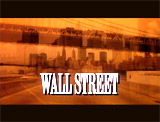
|
Wall Street (1987)
d. Oliver Stone, 126 minutes, 20th Century Fox/American Entertainment
Partners
- Writer/director Oliver Stone's thoughtful cautionary
'Faustian' treatise on the Me-Decade of stock trading was loosely
based on the junk bond and unethical insider trading scandals of
the mid-1980s. The popular film, although it wasn't a major box-office
hit or critical success, provided a perfect portrait of the WASP-ish
capitalistic, corporate-run culture and its power-mongering, money-hungry
financial traders who were often corrupted by wealth.
- The tale of greed, excess and corruption was
famous for its notorious "Greed
is...good" monologue
("Greed, for lack of a better word, is good. Greed is right.
Greed works. Greed clarifies, cuts through and captures the essence
of the evolutionary spirit. Greed, in all of its forms"). The
speech was delivered by predatory, slithery and ruthless, money-mad,
multimillionaire corporate financial trader/raider Gordon
Gekko (Oscar-winning Michael Douglas) to the annual shareholders'
meeting of Teldar Paper.
- Gekko's speech in the film was similar in theme
to corrupt Wall Street trader Ivan Boesky's commencement speech
at UC Berkeley's School of Business in 1986, who said: "Greed is
all right, by the way. I want you to know that. I think greed is
healthy. You can be greedy and still feel good about yourself."
Just a few months after the speech, Boesky was investigated by
the SEC for illegal trading and insider dealing scams, and ultimately
received jail time and stiff fines.
- During the many decades after its release, Stone's
defining film of the era had the opposite effect that the director
wanted. It hypnotized or seduced scores of would-be bankers and
traders to acquire business school degrees and become financial
social-climbers and stockbrokers. It also popularized so-called
tough-guy Gekko-isms, such as "Lunch is for wimps," "If
you need a friend, get a dog," "What's worth doing is worth doing
for money," and "If
you're not inside you're outside." Its cultural impact was also
evidenced on trading floors - slavish imitation of Gekko's style
of dress (slicked hair and suspenders), and copies of Gekko's favorite
book, military general Sun Tzu's The
Art of War ("If your enemy is superior, evade him. If angry,
irritate him. If equally matched, fight, and if not split and reevaluate").
- The film was released only a few months after the
massive stock market crash of October 1987 - reinforcing the idea
that there was an ugly and excessive side to trading
as well - also evidenced by the major economic downturn in 2008.
However, on the flip side, it served as a parable of the get-rich-quick
American dream - that anyone could transform themselves and succeed
(and have the high-flying perks of life: private jets, flashy clothes,
luxurious apartments, and trophy females) if they made it as an
insider.
- The character of Gordon Gekko became an enduring
symbol of greed. Fortune magazine featured a cover story in
June 2005 with a picture of Michael Douglas (as Gekko), asking the
question:
"Is Greed Still Good?" for a story spotlighting the
new greed of Wall Street.
- It was influential in inspiring other Wall Street-related
films, including Stone's own sequel Wall Street: Money Never
Sleeps (2010), and Martin Scorsese's The Wolf of Wall Street
(2013).
|
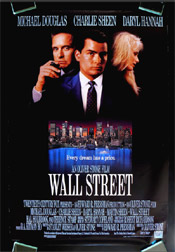
|
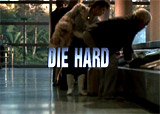
|
Die Hard (1988)
d. John McTiernan, 131 minutes, 20th Century Fox
- This highly-acclaimed, big-budget action film (and
quintessential guy film) was
the first in a series of profitable franchise films stretching
over a period of 20 years (from 1988 to 2013). It was one of the
greatest action
films ever made. It was the 7th highest-grossing
film of the year, at $83 million.
- This film of a single macho hero
pitted in combat against impossible odds in a single location ("Die
Hard in an Office Building") redefined action cinema and has been
copy-catted numerous times in various scenarios, such as "Die
Hard on a Mountain!" (Cliffhanger
(1993)), "Die Hard on a Bus!" (Speed (1994)),
or "Die
Hard on the President's Plane!" (Air
Force One (1997)), etc..
- After a decade of action cinema defined by
a number of self-parodying, un-real, beefcake muscle-bound actors:
Steven Seagal, Jean-Claude Van Damme, Sylvester Stallone (in the
Rambo films in 1982, 1985, 1988, and 2008) and Arnold Schwarzenegger
(starring in Conan
the Barbarian (1982), The
Terminator (1984), Commando (1985), Predator (1987),
and The Running Man (1987), and soon after Total
Recall (1990) - and famous for one-line deliveries), a new action adventure
hero was born.
- This film was originally planned
to be a sequel to Schwarzenegger's Commando
(1985) -
but when Schwarzenegger turned down the lead role, it was filled
with comedy and TV-actor Bruce Willis, known for his popular TV
show Moonlighting (1985-1989)
and his appearance in Blake Edwards' romantic comedy Blind
Date (1987).
He completely repositioned himself as a thrilling action hero - which
soon became his signature role.
- The character-driven Everyman
hero, John McClane (Bruce Willis), appeared as the protagonist
in all of the films. As a wise-cracking,
tough-guy NYC police cop with real
human vulnerabilities, he was reluctantly recruited
to ingeniously fight against the bad guys during a heist in a 40-story
LA high-rise building, led by archetypal European villain Hans
Gruber (Alan Rickman). The film (and its many sequels) were known
for white-T-shirted, wise-ass McClane's oft-censored line of dialogue: "Yippee-kai-yay,
motherf--ker."
- The action was set on Christmas Eve in 1988, with
off-duty NY cop John McClane in Los Angeles at the high-rise
Nakatomi Corporation Building (on the Avenue of the Stars in Century
City) for his estranged wife Holly's (Bonnie Bedalia) office party. Die
Hard (1988) has often been categorized as a "Christmas" movie,
and although that may be stretching things too far, there are some
notable references to the holiday.
|
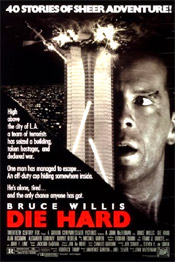
|
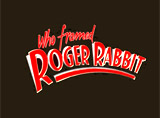
|
Who Framed Roger Rabbit (1988)
d. Robert Zemeckis, 104 minutes, Touchstone Pictures/Amblin
Entertainment/Silver Screen Partners III/Walt Disney
- A technically-marvelous film
blending animated, ink-and-paint cartoon characters and flesh-and-blood
live actors, in a convincing comedy/mystery noir thriller, set
in Los Angeles in 1947. Earlier efforts to combine humans and ink-and-paint
cartoon characters side-by-side in a film, such as Disney's Song
of the South (1946) and Mary Poppins (1964), can be
considered primitive next to this film.
- The story was a delightful
spoof of the hard-boiled Sam Spade films and reminiscent of the
recent Chinatown
(1974), (complete with a sultry, femme fatale humanoid
Toon named Jessica Rabbit (Jessica Turner, uncredited, with singing
voice by Amy Irving, executive producer Steven Spielberg's wife
at the time), and a case involving alleged marital infidelity ("pattycake"),
murder, a missing will, blackmail, and a conspiracy hatched by
evil, Toon-hating Judge Doom (Christopher Lloyd) (of Cloverleaf
Industries).
- The film was a milestone in animation history, one
of the top-grossing films of its year, and it received four Academy
Awards, one of which was a Special Achievement Award for Animation
Direction (Richard Williams). Director Robert Zemeckis must be
credited for piecing together the production that involved hundreds
of animators, and the special visual effects of George Lucas' Industrial
Light and Magic (ILM), Amblin Entertainment, Walt Disney and other
studios. As a result, it was the most expensive film of its decade,
at $70 million.
- It was filmed as a tribute to the entire pantheon
of cartoon characters from Disney, Warner Bros., and MGM, and other
studios in the 1940s. Famous cartoon voices were used (Mel Blanc
for Daffy Duck, Tweety Bird, Bugs Bunny, Sylvester, and Porky Pig
and Charles Fleischer for Roger, Greasy, Psycho, and Benny the
Cab), and the live-action characters were coordinated with cartoon
characters - the animations were drawn and inserted after the live
photography was shot.
- In this landmark film, the Toons included appearances
and cameos by Donald and Daffy Duck, Bugs Bunny, Porky Pig, Tweety
Bird and Sylvester, Woody Woodpecker, the Weasels - from Disney's The
Wind in the Willows (1949), Mickey Mouse, three hummingbirds
from Disney's Song of the South (1946), the Road Runner
and the Coyote, the black Crows and Dumbo from Disney's Dumbo
(1941),
Betty Boop, Droopy Dog, and many more. Unprecedented cooperation
from Warner Brothers and Disney allowed for classic cartoon characters
to be seen together for the first time, such as Mickey Mouse and
Bugs Bunny parachuting together, having both Tinkerbell and Porky
Pig end the movie, and, of course, the famous piano duel between
Daffy and Donald Duck in a Cotton Club-style nightclub, the Ink & Paint
Club.
- Its revolutionary animation: (1) used light
and shadows in new ways to produce remarkably realistic, 3-D effects;
(2) extensively panned and moved the camera to reduce a static
look; and (3) had the car'toon' characters interact flawlessly
with real-world objects and flesh-and-blood people as much as possible.
- Other animated and live-action mixed films would
be released soon after with the same technically-sophisticated
human/cartoon interaction, including Joe Pytka's Space Jam (1996),
Des McAnuff's The Adventures of Rocky
& Bullwinkle (2000), Henry Selick's Monkeybone (2001), and
Joe Dante's Looney Tunes: Back in Action (2003), but none of them
could recapture the same sense of awe or feature the same level of acting
and writing.
|
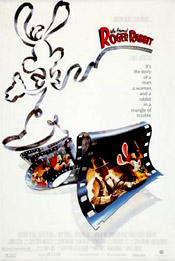
|
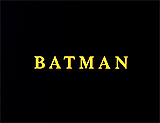
|
Batman (1989)
d. Tim Burton, 126 minutes, Warner Bros./Guber-Peters
Co./PolyGram Pictures
- Tim Burton's ambitious, hyped and over-marketed
production of a dark-shaded superhero character, the Caped Crusader,
was a Warners' mega-hit. The visionary, idosyncratic film
inaugurated a wave of more mature superhero films, following in
the footsteps of another simpler DC comics hero Superman
(1978), that hasn't let up to this day. It was promoted
with lucrative merchandising that became the blockbuster hit of
the last year of the decade, with an over-the-top performance by
Jack Nicholson as the villainous Joker ("Where
does he get those wonderful toys?").
- As an example of non-traditional, off-beat casting,
comedian Michael Keaton took on the serious, dual role as the comic
book hero - Bruce Wayne and the shadowed, dark avenger of Gotham
City (similar in design to the city in Fritz Lang's
expressionistic Metropolis
(1927, Germ.)), although his selection as the lead character
was considered controversial at the time.
- Batman became a critical and financial success
(although its budget skyrocketed to almost $50 million), earning
$411 million in box office totals (worldwide). It was the highest-grossing
(domestic) film of 1989, and remains in the top 100 highest-grossing
films of all time. It was also the first Batman movie
to win an Academy Award (Best Art Direction/Set Decoration).
- The film's poster was simply composed of the Bat
Symbol (although some interpreted it as an open mouth with buck
teeth). The corporate marketing campaign frenzy (dubbed "Batmania")
rose to new heights as a media and cultural sensation (with $750
million in merchandise sales), with the ubiquitous Batman-Bat-Signal
insignia visible on numerous products (hats, T-shirts, toys, lunchboxes,
buttons, billboards etc.), and two hit soundtracks (Danny Elfman's
dramatic score, and pop singer Prince's songs from the film). It
was amazing that it did so well, considering that it was competing
against three other massive franchises: Indiana
Jones and the Last Crusade (1989), Ghostbusters II (1989),
and Lethal Weapon 2 (1989).
- Its early summer opening weekend grossed $43.6
million, a new record. This fact accelerated the trend to focus
on opening weekend box-office receipts for these kinds of blockbusters. Batman was
notable as the first film to earn $100 million in its first ten
days of release. It also set a precedent as the highest-grossing
Batman movie, and the highest-grossing film based on a DC
comic book (both surpassed by The
Dark Knight (2008)).
- The film was the first to promote cheaper, more
affordable VHS tapes (rather than rentals) and it also reduced
the time gap between the theatrical showing and the date of
release to home video. Warner Bros. decided to release
the film to video just 4 months after its theatrical release. The
early release on November 15th was considered unprecedented at
the time. Smaller theatre chain operators, fearing their demise
or loss of revenue, were not happy with Warner's decision, but
the studio wanted to position the film for the Christmas holiday
gift-shopping season.
- Burton's vision created a more modern, superhero
pulp figure for the cinema - his film was the first dark comic
book movie with a tormented, stoic and brooding superhero, reflecting
the cynicism and angst of the generation, and influencing every
other subsequent superhero film (i.e., Spider-Man, Daredevil,
X-Men, etc.)
|
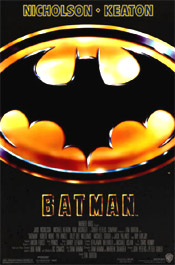
|
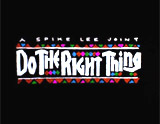
|
Do the Right Thing (1989)
d. Spike Lee, 120 minutes, 40 Acres & A
Mule Filmworks/Universal Pictures
- African-American writer/director Spike Lee's third
(and breakout) feature film was this complex, angry and unapologetic
social protest film about racism, racial pride, intolerance and
oppression, class struggle and violence. After
director Lee's first-directed feature film She's Gotta Have
It (1986), he negotiated a deal with Universal to direct a studio
film about racial conflict in the US.
- This controversial and
incendiary independent film, receiving a Best Original Screenplay
Academy Award nomination for Lee, was about racial tensions that
eventually erupted into a fiery riot on a sweltering summer day in
the multi-ethnic Bedford-Stuyvesant neighborhood of Brooklyn. Although
it was feared by film critics that this would cause and incite similar
responses from black urban-dwellers, this proved to be a misrepresentation
of the facts by the film's detractors, that dubbed the film "irresponsible." Two
contradictory quotations ended the film, one from Martin Luther King,
Jr. advocating non-violence, and the other from Malcolm X advocating
violent self-defense in response to oppression.
- It was
told with vibrantly bright colors, realistic and goofily-named
characters and dialogue, a supplementary "Greek
chorus" of black men on the corner commenting on the day's events,
and energetic editing and quasi-documentary, cocked camera angles.
- During the opening credits, Public Enemy performed
the film's hard-edged anthem and title song, Fight the Power -
foreshadowing the coming emergence of rap and hip-hop music into
the mainstream culture.
- The multi-ethnic cast of the film provided three-dimensional
characters and day-in-the-life stories, and featured the early career
work of Samuel L. Jackson (as DJ Mister Senor Love Daddy) and Rosie
Perez (as demanding single mother and girlfriend Tina).
- Following the film's success, Lee went on to make
the big-budget studio film Malcolm X (1992), starring Denzel
Washington as the controversial, assassinated civil rights leader
- a role for which he received his first Best Actor nomination.
Later, for Training Day (2001), Denzel Washington won
Best Actor and became the second African-American in Oscar
history to do so.
- Lee's landmark black-oriented films inspired a new
generation of African-American film-makers, including John Singleton
(Boyz 'N the Hood (1991)).
|
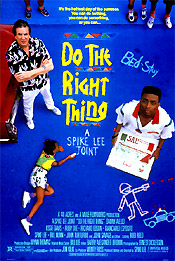
|
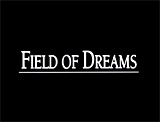
|
Field of Dreams (1989)
d. Phil Alden Robinson, 107 minutes, Gordon Company/Universal Pictures
- This sentimental, intensely-popular modern fantasy-drama
classic became a smash hit in its unique depiction of Americana
and the power of dreams. The inspiring, tearjerking story, an unexpected
success, was an uplifting fairy tale that celebrated the love of
the game of baseball - adapted by screenwriter/director Phil Alden
Robinson from W. P. Kinsella's 1982 novel Shoeless Joe.
- It was an almost dreamlike, mythic heroic quest
by the main character (aided by the mystical score by James Horner)
about how baseball was a metaphor for a second redemptive chance
at love, and a way to reestablish family connections (especially
between father and son).
- The film received three Academy Award nominations:
Best Picture, Best Adapted Screenplay (Phil Alden Robinson), and
Best Original Score. It grossed $64.4 million (domestic) at the
box-office after a long theatrical run.
- Just one year after playing catcher "Crash"
Davis in Bull Durham (1988), Kevin Costner appeared in this
second sports film - another baseball-themed film coupled with the
religious themes of faith and redemption. This film was both nostalgic
for earlier, more idyllic times, and a celebration of life in the
1980s (following the Reagan Presidency), after so much hardship in
the decades that had come before (marred by the Watergate affair,
the many assassinations in the 1960s, and the drawn-out Vietnam War).
An earlier film with similar sports themes was The Natural (1984).
- Idealistic Ray Kinsella (Kevin Costner), a transplanted
city boy-turned-Iowa corn farmer, heard a whispered, ghostly disembodied
Voice telling him to build a baseball diamond in the middle of
his corn field ("If you build it, he will come"), to "ease
his pain."
His wife Annie (Amy Madigan) was semi-supportive but worried about
their finances if they plowed down their field.
- Ray met with various sad and wistful
icons, including the ghost of Shoeless Joe Jackson (Ray Liotta) (his
father's favorite player) and other disgraced team players who were
banned from baseball for life after the 1919 Chicago "Black" Sox
World Series scandal. No one but those
who believed could see the ghostly ballplayers who began to appear
from the adjacent cornfield. This Capra-esque
film recalled Harvey (1950), a film in which its main character
believed he was befriended by a giant rabbit that no one could see.
Ray's daughter Karin (Gaby Hoffmann) was watching Harvey on
TV at one point in the film, to emphasize the connection.
- He also met a disillusioned, former 1960s, reclusive
J.D. Salinger-like, radical writer in Boston named Terence Mann (James
Earl Jones), and a small-town doctor named Doc "Moonlight" Graham
(Burt Lancaster) - a rookie player who years earlier yearned to make
it into the major leagues.
- The film reached its climax with Mann's
famous monologue on the place of baseball in American history: "The
one constant through all the years, Ray, has been baseball. America
has rolled by like an army of steamrollers. It's been erased like
a blackboard, rebuilt, and erased again. But baseball has marked
the time. This field, this game, is a part of our past, Ray. It reminds
us of all that once was good, and that could be again. Oh people
will come, Ray. People will most definitely come." [Note: In fact,
people still visit the baseball diamond built for the film, located
on farm land in Dyersville, Iowa.]
- In the final scene at sunset, Ray realized that
the New York Yankees catcher removing his
equipment at home plate was his dead and estranged father John
Kinsella (Dwier Brown): "It's
my father-- ease his pain." In their final exchange together
in the twilight, the two reconciled and wondered if they were in
heaven - a place where dreams came true. The film ended with a
long shot of the two playing catch together on the ball diamond
with the lights turned on, and an overhead shot of a stream of
car headlights approaching from the distance.
|
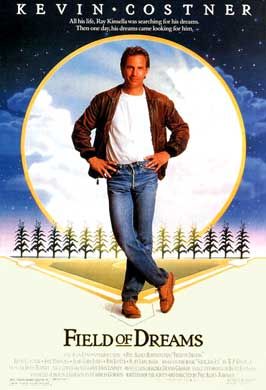
|

|
sex, lies, and videotape (1989)
d. Steven Soderbergh, 100 minutes, Outlaw Productions/Virgin
- This was versatile and cerebral independent film-maker/writer-director
Steven Soderbergh's low-budget, minimalist, and provocative character-driven
debut film, with great naturalistic, spontaneous performances.
- The sexually-suggestive film featured four Baton
Rouge, Louisiana characters, but without obvious or overt scenes
of sexual activity or nudity: a childless married couple - egotistical
yuppie lawyer John and his neglected, frigid, sexually-squeamish,
repressed and frustrated wife Ann Mullany (Peter Gallagher and
Andie MacDowell in her first major screen appearance), the wife's
sexually-adventurous, promiscuous bartender sister Cynthia Bishop
(Laura San Giacomo), and a reclusive high-school friend Graham
Dalton (James Spader) of the husband. His "personal project" was
to 'voyeuristically' videotape the women talking
about their complex sex lives.
- The
film featured explicit dialogue within the videotaped discussions
and revelatory confessions. The conversations included candid observations
about masturbation, penises and orgasms. Videotaping was a substitute
for his own emotion-less, impotent and dispassionate life ("I'm
impotent - I can't get an erection in the presence of another person")
as he admitted openly that he ‘got off' on taping women talking
about their sexual experiences ("Why do these tapes all have
women's names on them?").
- Its premiere at Robert Redford's
1989 Sundance Film Festival (then named the US Film Festival) captured
everyone's attention and helped to encourage the production of
other thought-provoking indies. It was the winner of the top prize
(Palme d'Or) at the Cannes Film Festival (and 26 year-old Soderbergh
was the youngest director to ever receive the prestigious prize).
It also won at the Independent Spirit Awards, and received an Oscar
nomination for Best Original Screenplay - a sure-fire commercial
and critical success.
- It became a box-office hit for its fledgling distributor
Miramax at the time (with co-founder Harvey Weinstein), which
would soon become the leading and most aggressive distributor -
to niche markets - of risky and popular independent films.
- This
marked a turning point in American independent cinema - the introduction
of a new era of indie blockbusters, almost evaluated on a similar
scale as the major, high-concept event pictures of the big studios.
The gap between independents and mainstream films was not as
large as it once appeared, and the label of 'art-house' film was
no longer a death knell.
- Comparing cost-earning ratios
in the same year, Batman
(1989) had a budget
of $50 million and box-office revenue of $250 million (domestic).
Even more impressively,
sex, lies, and videotape, made on a budget of $1.1 million,
grossed $25 million in domestic box office revenue. The film set
a new benchmark for an 'art-house' hit - indies were now seen as
commercially viable products (although for some of the smaller indies,
they were now faced with impossible and unrealistic benchmarks).
- Although Soderbergh
would continue making various films in the next decade, his breakthrough
came with more mainstream films: Out of Sight (1998), Erin
Brockovich (2000), Traffic (2000), Ocean's Eleven (2001)
(and its sequels), The Good German (2006), and Magic
Mike (2012).
However, he was still experimenting with less commercial, more experimental
titles such as Kafka (1991), Gray's Anatomy (1996), Schizopolis
(1996), Full Frontal (2002), and Bubble (2005).
|
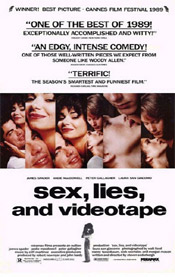
|
